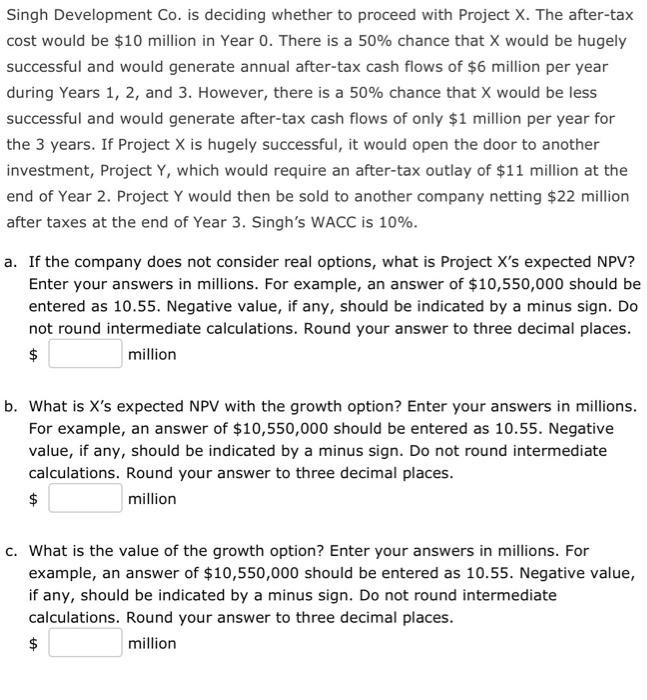Singh Development Co. is deciding whether to proceed with Project X. The after-tax cost would be $10 million in Year 0 . There is a 50% chance that X would be hugely successful and would generate annual after-tax cash flows of $6 million per year during Years 1, 2, and 3. However, there is a 50% chance that X would be less successful and would generate after-tax cash flows of only $1 million per year for the 3 years. If Project X is hugely successful, it would open the door to another investment, Project Y, which would require an after-tax outlay of $11 million at the end of Year 2. Project Y would then be sold to another company netting $22 million after taxes at the end of Year 3. Singh's WACC is 10%. a. If the company does not consider real options, what is Project X's expected NPV? Enter your answers in millions. For example, an answer of $10,550,000 should be entered as 10.55. Negative value, if any, should be indicated by a minus sign. Do not round intermediate calculations. Round your answer to three decimal places. $ million b. What is X's expected NPV with the growth option? Enter your answers in millions. For example, an answer of $10,550,000 should be entered as 10.55. Negative value, if any, should be indicated by a minus sign. Do not round intermediate calculations. Round your answer to three decimal places. $million c. What is the value of the growth option? Enter your answers in millions. For example, an answer of $10,550,000 should be entered as 10.55 . Negative value, if any, should be indicated by a minus sign. Do not round intermediate calculations. Round your answer to three decimal places. $million Singh Development Co. is deciding whether to proceed with Project X. The after-tax cost would be $10 million in Year 0 . There is a 50% chance that X would be hugely successful and would generate annual after-tax cash flows of $6 million per year during Years 1, 2, and 3. However, there is a 50% chance that X would be less successful and would generate after-tax cash flows of only $1 million per year for the 3 years. If Project X is hugely successful, it would open the door to another investment, Project Y, which would require an after-tax outlay of $11 million at the end of Year 2. Project Y would then be sold to another company netting $22 million after taxes at the end of Year 3. Singh's WACC is 10%. a. If the company does not consider real options, what is Project X's expected NPV? Enter your answers in millions. For example, an answer of $10,550,000 should be entered as 10.55. Negative value, if any, should be indicated by a minus sign. Do not round intermediate calculations. Round your answer to three decimal places. $ million b. What is X's expected NPV with the growth option? Enter your answers in millions. For example, an answer of $10,550,000 should be entered as 10.55. Negative value, if any, should be indicated by a minus sign. Do not round intermediate calculations. Round your answer to three decimal places. $million c. What is the value of the growth option? Enter your answers in millions. For example, an answer of $10,550,000 should be entered as 10.55 . Negative value, if any, should be indicated by a minus sign. Do not round intermediate calculations. Round your answer to three decimal places. $million







